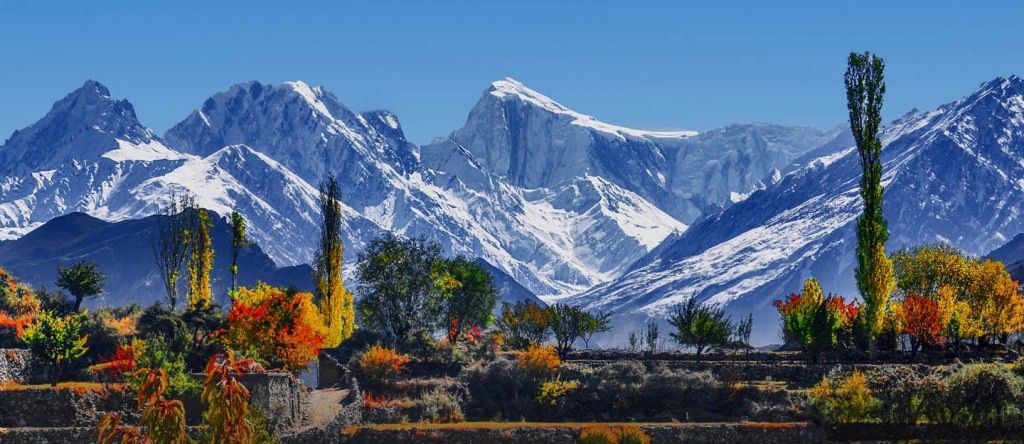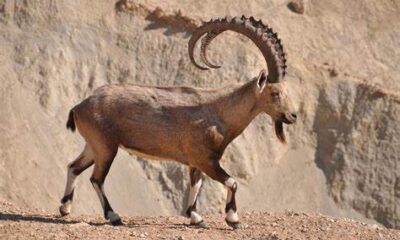Article
Hunza Valley is looking your way
Published
8 months agoon

Oh..! How to exclude Hunza Valley when there is a discussion about tourism? It is the hub of tourist spots. Every single area of this valley is full of breathtaking and left with astonishment and surprise. Its beauty is undesirable so let me tell you about its direction. The valley of Hunza is situated at the bank of the Hunza River in the northern part of Gilgit-Baltistan, Pakistan. It is bordering with Ishkoman to the northwest, Shigar to the southeast. Afghanistan’s Wakhan Corridor touches it in the north and the Xinjiang region of China to the northeast.
However, the Hunza Valley is at an altitude of 2,438 meters (7,999 feet). Geographically, Hunza consists of three regions: Upper Hunza (Gojal), Central Hunza, and Lower Hunza (“Shinaki”). And of these divisions have their own nature spots. The inscribed mountains and hills tell the tale of ancient times. People are as natural as the place. The whole valley enshrined you with love and care. You might think why to visit Hunza valley so here are the reasons.
Why have a visit to Hunza Valley?
Height is always a fascination to man so Hunza has got the natural height. There are many high peaks above 7000m in the surrounding of the Hunza Valley including these Rakaposhi 7,788 m (25,551 ft), Ultar Sar 7,388 m (24,239 ft), Bojahagur Duanasir II 7,329 m (24,045 ft), Diran peak (7,266), Spantik (7027m), Ghenta Peak 7,090 m (15,631 ft), Hunza Peak 6,270 m (20,571 ft), Darmyani Peak 6,090 m (19,980 ft), and Bublimating (Ladyfinger Peak) 6,000 m (19,685 ft).
Besides this, you can find some more like Distaghil Sar, Batura, Batura II, Batura III, Muchu Chhish, Kunyang Chhish, shispare, Passu Sar, Kanjut Sar, Yukshin Gardan Sar, Pumari Chhish, Momhil Sar.
However, man is also interested to know about his history. So you can find different castles and inscribed mountains and stupas that tell more about history. You must have to visit the castle of Baltit, above Karimabad, which is a Hunza landmark built about 800 years ago. Stilted on massive legs, its wooden bay windows look out over the valley. Originally, it was used as the residence of the Mirs (the title of the former rulers) of Hunza.
Other than this Hunza Valley is also host to the ancient watchtowers in Ganish, Baltit Fort, and Altit Fort. Watchtowers are located in heart of Ganish Village. Baltit Fort stands on top of Karimabad whereas Altit Fort lies at the bottom of the valley. Dating back to the 8th century AD, a huge Buddha figure surrounded by small Buddhisatvas is carved on a rock. Pre-historic men and animal figures are carved on rocks along the valley. Some lakes like Attabad Lake, Borith Lake, Shimshal Lakes, Hassanabad Lake are located in Hunza.
After that, you can go a beautiful evening visit to Khunjerab Pass that is a 4,693-meter-high mountain pass in the Karakoram Mountains. It is in a strategic position on the northern border of Pakistan and on the southwest border of China is also located in Hunza. Moreover, Hunza is the best place for hiking. You can hike up and down on the Ondra Poygah Gulmit and Leopard Trek Shiskhat.
The beauty is not just inside the valley but also on the ways towards it. One can witness the 57 km long Batura Glacier, the fifth-longest glacier in the world outside the polar region, surrounded by Shispare, Batura, and Kumpirdior peaks. Upon reaching Sost one can continue the journey up to Khunzhrav or turn west to the Chipursan (also Chapursan) Valley. In Yarzerech (also Yarzirich), one can have a look at Kundahill peak (6,000 m), or trek along the Rishepzhurav to the Kundahill. Beyond Yarzerech, one can travel further to Lupghar, Raminj, Reshit, Yishkuk up to Bobo Ghundi (Oston), the shrine of Baba-e-Ghund, a saint from Afghanistan near the border between Pakistan and the Wakhan region of Afghanistan.
This is all about Hunza Valley and now you need to know about the routes so that you can reach your destination of natural beauty.
Ways to Hunza Valley
The journey is a bit long but not tiring for nature lovers. There are two methods that you can take for your tour to Hunza. First, if you want to go by air then it will land you at the airport of Gilgit because there is no airport in the Hunza valley. From Gilgit, you can hire a tax and easily reach the valley of worldly heaven. Secondly, you have the option of by road transportation. And for that again there are two routes one is through Kohistan in KPK and the other, which is the shorter one through the Babusar Top all the way from Naran. It is up to you whether you want to avail the of public transport or to hire a cab for you. The distance is about 582 km from Islamabad to Hunza.
Suggestion
The government needs to promote tourism and should facilitate the people in their visits to tourist spots. This can boost the economy of Pakistan.
Book your seats and enjoy your trip.
You may like
-


Unity, Faith, and Discipline: The Cornerstones of Pakistan’s Motto as “Aik Qaum” (One Nation)
-


Aik Qaum: The Fusion of Integrity and Patriotism
-


“AIK QAUM” DECLARATION OF CONCEPTION
-


Dr. Abdul Qadeer Khan: The Real Hero of Pakistan
-


The Chiltan Ibex: A Rare Treasure of Balochistan
-


MANGO HEALTH BENEFITS NUTRITION
Article
Aik Qaum: The Fusion of Integrity and Patriotism
Published
3 weeks agoon
May 28, 2025By
EDITOR
We keep Integrity closest to our Heart and Patriotism on top of our mind.
Integrity and patriotism are not separate entities; they are intertwined in the soul of Pakistan. The people understand that to be a patriot is to uphold the principles of integrity. Honesty and love for one’s country are two sides of the same coin. Together, these values form the essence of “Aik Qaum.”
The fusion of integrity and patriotism is evident in the everyday lives of Pakistanis. It’s in the farmer toiling the fields, the teacher educating the youth, and the soldier guarding the borders. It’s in the child who dreams of a better Pakistan and the elderly who have seen the nation grow. “Aik Qaum” is the realization that integrity and patriotism are the heart and mind of Pakistan, beating in unison to guide the nation forward.
As we celebrate the spirit of “Aik Qaum,” we honor the values that make Pakistan a unique and resilient nation. Integrity and patriotism serve as our guiding stars, leading us towards a brighter and more prosperous future. In the heart of every Pakistani and at the forefront of their minds, “Aik Qaum” stands as a testament to the strength of a united nation, bound by the principles of integrity and the unyielding love for their homeland.
In Pakistan, “Aik Qaum” is not just a motto; it’s a way of life that embodies the enduring spirit of a proud and united nation.

Our Initiative
The fabric of the Pakistani nation has something unique in its knit, something signature and so sanguine that could keep on energizing its very fibers irrespective of the floods of considerably tough challenges posed against it since its inception. There is also a belief that Pakistan has been blessed with such a golden glitter that couldn’t be ignored by any sensible system of reason and knowledge among the league of free, upright and kind nations. The credit goes to the amazing people of Pakistan. It is more exciting to find that the people of Pakistan, be it the businessmen, doctors, parents, soldiers, students, teachers, judges, labourers or lawyers etc, have assumed the duty bestowed upon them by the founder of the nation, Quaid-e-Azam Muhammad Ali Jinnah decades ago. Quaid once said “If you will work in cooperation, forgetting the past, burying the hatchet, you are bound to succeed.” At another occasion, Quaid summed this message up in just three words: Unity, Faith and Discipline. AIKQAUM.COM is an initiative built upon the idea of translating this vision of the founder of Pakistan, Quaid-e-Azam Muhammad Ali Jinnah into a fruitful action.
There is no power on earth that could restrict us from finding those beautiful commonalities among the people of this beautiful nation. It contends to promote the psyche morale of the Pakistani nation by addressing the issues instead of dodging them. We have a team of thorough professionals fully equipped to create unique platforms, forums and projects which will bring people closer on all sensitive issues related to our national identity and progress. We also have a strong support network for successful execution of all our campaigns in order to induce greater cohesion and the spirit of coexistence across the length and breadth of Pakistan. Coincidentally, we are living through an age of increased morphing of warfare in a world that’s once again moving from unipolar to a multipolar turf. The social, political, economic and technological factors shaping the evolution of warfare are being constantly experimented and employed in our own region. In a time of increased friction between regional powers and a heightened threat on the eastern border, Pakistan faces multiple challenges posed at its internal, external and economic security.
All these factors, blended with our archrival’s constant image building campaigns, a heavily funded lobbying in the West, the new Indo-US strategic alliance, as well as India’s ambition to start a space race, puts our nation on caution and throws immense burden of responsibility on our shoulders. We are witnessing a rise of sub conventional warfare fought with guns and bombs, but won on keyboards and drawing boards. AIKQAUM.COM aspires to be a strong force of defense against the subversive forces that are trying to malign Pakistan and hurt our interests in the region. We are fully trained and equipped to meet the challenges on the social and digital front.
www.aikqaum.com, info@aikqaum.com
Our Philosophy
VISION:
To create a social awareness about the values which join our nation together while countering anti-Pakistan narratives with logical and practical rationale.
MISSION:
To infuse a sense urgency for cohesion among all ethnic, political and religious schools of thought.
VALUES:
We keep integrity closest to our heart and patriotism on top of our mind. Our work ethics and commitment to our people shall empower us to achieve success in all our pursuits.
Article
The Chiltan Ibex: A Rare Treasure of Balochistan
Published
2 months agoon
April 16, 2025By
EDITOR
The Chiltan ibex (Capra aegagrus chiltanensis), a subspecies of the wild goat, is one of the most unique and endangered animals native to Pakistan. Found exclusively in the rocky highlands of the Chiltan range within the Hazarganji-Chiltan National Park in Balochistan, this elusive animal represents the region’s rich biodiversity and ecological heritage.
Physical Characteristics
The Chiltan ibex is a strikingly beautiful species, with a robust, muscular build perfectly suited for navigating steep and rocky terrains. Males are particularly distinctive, boasting impressive curved horns that can grow up to 30 inches (76 cm) in length. Their coat is light brown, with a darker stripe running along their back and legs, providing excellent camouflage in their arid mountainous habitat.
Females are smaller in size with shorter, more slender horns, and their coloration is less pronounced, blending seamlessly into their surroundings. This camouflage helps protect them and their offspring from predators such as wolves and large birds of prey.
Habitat and Range
The Chiltan ibex inhabits the rugged, semi-arid regions of the Chiltan range, located within the Hazarganji-Chiltan National Park, southwest of Quetta. These high-altitude areas, ranging from 1,500 to 3,200 meters above sea level, are characterized by rocky cliffs, sparse vegetation, and extreme weather conditions.
The ibex is well-adapted to this challenging environment, where it feeds on grasses, shrubs, and the leaves of juniper trees. Its ability to climb steep slopes and jump across narrow ledges gives it a unique advantage in escaping predators and surviving in such inhospitable terrain.
Behavior and Social Structure
Chiltan ibexes are diurnal, meaning they are active during the day. They are typically found in small groups, with herds consisting of females and their young. Males are more solitary, joining herds only during the breeding season, which occurs in the late autumn and winter months.
During this time, males engage in dramatic displays of strength to compete for mating rights, including horn clashing and dominance rituals. After a gestation period of around six months, females give birth to one or two kids in spring, when food availability is higher.
Conservation Status
The Chiltan ibex is classified as endangered due to its restricted range, habitat loss, and poaching. Habitat degradation caused by overgrazing, deforestation, and human encroachment poses significant threats to its survival.
Historically, the ibex faced heavy hunting pressure for its horns, considered a symbol of prestige, and for its meat. Although hunting is now banned in the national park, illegal poaching remains a concern.
Conservation Efforts
To protect the Chiltan ibex and its fragile ecosystem, the Hazarganji-Chiltan National Park was established in 1980. Spanning over 32,500 acres, the park provides a safe haven for the ibex and other wildlife, such as wolves, foxes, and birds of prey.
Conservation efforts include:
- Anti-Poaching Measures: Increased patrolling and strict enforcement of hunting bans have helped reduce poaching incidents.
- Habitat Restoration: Programs to control overgrazing and reforest juniper woodlands are underway to restore the ibex’s natural habitat.
- Public Awareness Campaigns: Local communities are being educated about the importance of biodiversity and the role of the Chiltan ibex in maintaining ecological balance.
- Eco-Tourism Initiatives: Promoting responsible tourism generates revenue for conservation projects and raises awareness about the ibex’s plight.
Ecological Importance
The Chiltan ibex plays a vital role in its ecosystem as both a grazer and prey species. By feeding on shrubs and grasses, it helps maintain vegetation balance, preventing overgrowth and contributing to soil health. At the same time, it serves as a food source for predators, sustaining the natural food chain.
Protecting the ibex is not just about saving a single species—it’s about preserving an entire ecosystem that supports numerous forms of life, from tiny insects to apex predators.
Cultural Significance
For the people of Balochistan, the Chiltan ibex is more than just a wild animal; it is a symbol of the region’s natural beauty and resilience. Local folklore often intertwines with the ibex, celebrating its agility and strength. The species also draws international attention, making it a flagship for wildlife conservation in Pakistan.
The Future of the Chiltan Ibex
While conservation efforts have shown promise, the Chiltan ibex remains vulnerable. Protecting this rare species requires continued collaboration between government agencies, conservation organizations, and local communities.
By safeguarding the Chiltan ibex, we not only preserve a unique animal but also protect the fragile ecosystem of Balochistan, ensuring that future generations can marvel at the beauty and resilience of this incredible species.
The Chiltan ibex is a testament to nature’s ability to adapt and survive in the harshest of environments. As efforts to protect it continue, this majestic animal stands as a beacon of hope for wildlife conservation in Pakistan.

Unity, Faith, and Discipline: The Cornerstones of Pakistan’s Motto as “Aik Qaum” (One Nation)

Aik Qaum: The Fusion of Integrity and Patriotism








